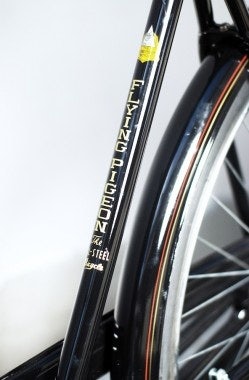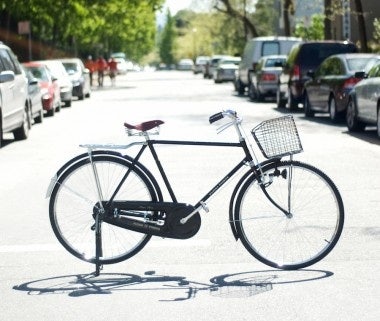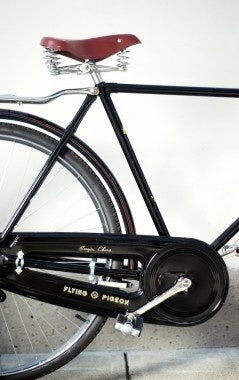Jing Daily Interview With Bayan Ferzandi And Patrick Conn#

Fueled by a wave of nostalgia sweeping China's "post-80s generation", home-grown Chinese brands established between 1949 and the country's economic "opening" of the 1980s are starting to make a comeback. Looking to catch the opportunity, in recent years some enterprising individuals and companies have sought to "revive" moribund Chinese labels, aiming them squarely at the same young urban taste-makers coveted by Western and Japanese brands.
Interestingly, some of the more motivated individuals breathing new life into Chinese brands are not Chinese at all. From footwear maker Feiyue, run by a French team since 2006, to the sneaker and bag label ospop. and watchmaker Iguzzini, a handful of expat entrepreneurs are introducing retro Chinese brands to a new generation of consumers in China as well as abroad. Jing Daily editor Avery Booker recently spoke with Bayan Ferzandi and Patrick Conn, part of the Canadian team readying the 61-year-old Chinese bicycle brand Flying Pigeon for its largest North American rollout to date.
Jing Daily (JD): Can you give us a little background about the Flying Pigeon?#
Bayan Ferzandi (BF):#
The Flying Pigeon is a brand from Tianjin, China, which essentially came together in 1949-1950 with the coming to power of Mao. Early on, the brand took inspiration from Europe and the European aesthetic of bicycles, and the rationale was to provide a semblance of freedom and the ability to enjoy the cities and communities that Chinese people lived in. The aesthetic, functionality and production has really remained unchanged from 1950 to now. The Flying Pigeon you’re getting now from us is essentially the same Flying Pigeon you’d have ridden in Tianjin or Shanghai or Beijing 60 years ago.
The Flying Pigeon really fits in to what’s happening now in Vancouver in terms of fashion and culture. The city’s really evolving into a bicycle city. People are starting to change the way they experience the city, and everything now is revolving around a slower means of transportation. Three of the four business partners in our company have lived in China, and we all had Flying Pigeons over there, so it’s a natural extension for us to bring together these two cultures. And the bicycle fits so well with where Vancouver is going as a city, but really this goes for all cities, in terms of bike programs, bike lanes…people are staring to understand how important it is to move towards a different way of living. A slower movement.
Patrick Conn (PC)#
: And Vancouver’s demographics have a strong flavor of the East. Most of our population is made up of South Asians and [East] Asians, and with Vancouver moving more towards being a bike city, we thought this would be a good way to segue between the two cultures. Being on the Pacific Rim, Vancouver is often called the “Gateway to the Pacific”, and that couples well with the bike culture that’s growing here.

JD: What exactly was it about this brand that sparked your interest in bringing it to the North American market?#
PC#
: We wanted to evolve the idea of bringing Chinese brands to North America and branding them in a way that’s representative of the traditional culture, but changed for this market. We like to use this term, “trans-creation”, which is paying homage to the brand story but making it relevant to this market. We see our company being a gateway between the two markets, and the Flying Pigeon was the most relevant [brand] for what’s culturally happening in Vancouver but also North America. So this idea of bringing the bike over made sense from a brand perspective but also culturally made sense, and was really indicative of what’s happening here.
BF#
: From a marketing perspective, also we get to be in control of a brand, which allows us to do everything we want to do without having to deal with a client. We’re able to be free and truly creative, and we’re really looking to tell a cohesive story.
Plus, the bike has been organically branded. It’s got a great deal of history and it’s a gorgeous bicycle, so we’re really just, as Patrick said, “trans-creating” it for this market and trying to tell its story.
PC#
: There are so many little bizarre things about the bike. Like when it first came out, it was Mao’s goal for everybody to have three things: a Flying Pigeon, a sewing machine, and a pocket watch. Just those little things that are so unique to the culture and its ideals at the time.
JD: China has several heritage bicycle brands from the same period as the Flying Pigeon, like Forever (永久) and Phoenix (凤凰). What drew you to Flying Pigeon? Was there something about the brand itself that attracted you to it?#
PC#
: I think it has the most unique story, and that storytelling is the most powerful part for us. Looking among the three [bike brands], there are similarities visually but, aesthetically, I think Flying Pigeon is the best out of the three, and when you look at its typography, the badge on the front, it’s almost like something that could be in an art installation. It aligns so well with the way culture and fashion are going here.
BF#
: And it was the first of the three, so it’s got the most history. Plus, the name isn’t something you’d ever forget. It’s almost bizarre, but it’s a great name.
JD: Several “retro” Chinese brands have been revived in recent years, often by Westerners. I’m curious about how you look at the idea of a niche market being formed in North America for retro brands that are distinctly Chinese.#
PC#
: The most interesting part of this is the perception of “Made in China”. The interesting thing about this whole process is how we can change and shift people’s perception of brands from China through effective communications. I think the shift is already taking place, and that’s a powerful thing for us to be part of now. It’s very niche, but our strategy to get in with a certain type of buyer is, at the beginning, about getting in with an influencer, someone who respects and understands culture, fashion and art.
BF#
: Plus, as the Chinese become wealthier a lot of them are leaving China, and later they often like to associate themselves with the country they come from. So they see these retro brands are cool again and enjoy seeing something made in China or derived from China elsewhere in the world.
JD: Yeah, we recently spoke with Ben Walters of Ospop who uses the tag line “Proudly Made in China”, it’s a similar idea.#
PC#
: Right there on the bike’s top bar, you see it every time you mount the bike, it says “Made in China”. It’s something that’s not hidden, it’s not on the underside of the crank.
BF#
: And it’s important for people in North America to see it’s a beautiful and timeless piece of machinery. It’s been part of the fabric of China for 60 years and that shifts the whole idea and consumer perspective of what’s happening in China.
JD: Which Flying Pigeon models are you bringing to the North American market, and are you tailoring them to consumer preferences there at all?#
BF#
: We’re bringing the original two models. There’s the PA-02, the male version with the single top bar. There was an option with a double top bar, which was originally commissioned by Mao, that could handle the weight of a pig, so you could carry a pig to market. But we opted for the single bar for weight and cost savings. Then there’s the female step-through version with the skirt guard and a more elegant aesthetic. A more Dutch style.
We upgraded both of these with cable brakes, and upgraded the pedals, tires, wheels, seats, handlebars and grips. We sourced these parts from Flying Pigeon’s more modern bike models for functionality and safety. Vancouver’s not a hilly city by any means, but we wanted to make sure the brakes could handle hills.
PC#
: It’s been customized to a degree for North America, because rod brakes might work for China, where it’s relatively flat, but we have to be cognizant that we could potentially ship these bikes to cities that have all kinds of different conditions.

JD: Who’s your target market in North America?#
PC#
: A younger creative class, mostly, but people who are culturally aware, whether that’s in terms of art, fashion or business. They’re very much their own individuals, often well traveled, educated. But that being said it kind of transcends age group. We can imagine seeing a guy on a Flying Pigeon who’s 75 years old or it could be an 18-year-old who’s using it to get to his or her first job.
BF#
: We’ve also had interest from wealthy empty-nest boomer-type guys. One was a former stockbroker who fell in love with the Flying Pigeon and ordered four of them for his whole family. We aim at certain demographics but it’s tough to put a finger on it.
JD: What price range are you shooting for, and where will you sell the bikes in North America?#
BF#
: The push is going to be on the online store we’re creating, and we have a pop-up store in Vancouver, in a neighborhood called Gastown. It’s kind of the cultural hub of Vancouver. The price point we’re shooting for is $475. We want it to be under $500. There are obviously some headaches dealing with the Chinese and Canadian governments, lots of taxation involved with bringing bikes in from China. So that price point is what’s feasible.
PC#
: Canada is probably literally the worst place to bring a bike from China into. So we’re doing a limited release to get a sense of the market and demand from outside of Vancouver. It’s a phased approach right now, which is all driven online. We’ve been in talks with retailers who could move us into the US market, but the issue is importation and the differences in costs and duties. The idea is to find the most efficient way to get the bikes into the U.S. without having to have them come through Canada.

JD: How do you plan to promote the brand? Are you sticking to a fully digital strategy, organizing special events, or planning something else?#
PC#
: We’re going fully digital. The essence of our strategy is to create content that’s spreadable and tells the story in a unique way. That involves everything from video to contesting to photography, so we’re bringing the right team in to take what we’re trying to do to another level.
BF#
: And another thing is that it’s got to be authentic. Although we’re leveraging people with a lot of online influence, everything we do with these people has to be authentic, and that’s an issue for them as well. They have their own personal brand, and there needs to be synergy between the two. When everything clicks and makes sense in terms of brands and collaborators, it makes spreadability that much easier.
JD: So when is the official launch?#
BF#
: The formal launch will be in just over a week, but the retail pop-up will launch next week, and the initial load of bikes will arrive within the next five days. The contesting, video and really the entire online rollout will take place in the next week and a half.
JD: Is there anything else about the Flying Pigeon that you’d like Jing Daily readers to know?#
PC#
: The most interesting thing with projects like this is the power of branding to shift perceptions, and that’s what we’re most fascinated by. Evolving the way people have been experiencing Chinese brands and helping the growth of these Chinese brands. We think the Flying Pigeon can really become a part of people’s lives the way it has for people in China for decades.
We feel it is really going to be an interesting case study in that regard.